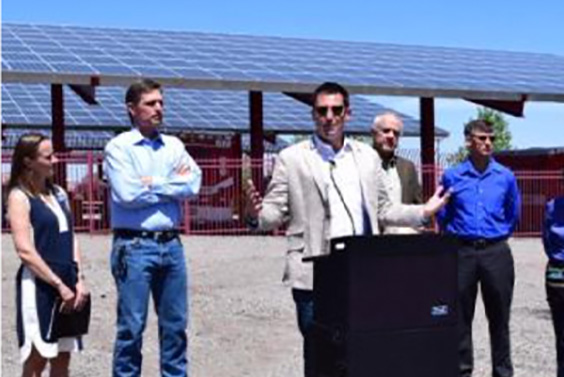TOWN OF SILVER CITY
Town of Silver City on utilizing Power Purchase Agreements for its wastewater treatment plant.
Wastewater plants and drinking water systems can account for up to one-third of a municipality’s total energy bill. Treating wastewater and stormwater, as well as pumping drinking water from deep ground-water wells are costs that are invariably passed on to the consumer. Around the time of the inception of the Town of Silver City’s Office of Sustainability in 2009, an opportunity became available to decrease the Town’s wastewater treatment costs significantly through the installation of a photovoltaic array that powers most of the wastewater treatment plant facility.
The Town of Silver City began approaching the idea of sustainability and resiliency in 2007 when the Mayor appointed concerned citizens to form the Mayor’s Climate Protection Agreement Citizen’s Advisory Committee (the Climate Committee). The resulting Climate Action Plan, presented to the Mayor and the Town Council in January 2009, laid out a pathway to decrease greenhouse gas emissions on a local level. One of the plan’s key recommendations was realized in 2010 when the Office of Sustainability was formed within Silver City’s Community Development Department. In the fall of 2012, a public/private task force was formed to develop and present a sustainability plan. After seven months, the task force completed the Town of Silver City Sustainability Plan 2030, Protect, Conserve, Prepare, An Approach to Community Resiliency.
Once the contract was signed in 2013, construction started, and in less than six months the one Megawatt array of photovoltaic panels covering six acres adjacent to the Wastewater Treatment Plant was up and running. Around 5,000 photovoltaic panels make up the array.
What tools, resources or financing did you use to establish your project?
Legislation enacted in 2011 by the State of New Mexico created a unique funding opportunity for municipalities to install money-saving photovoltaic (PV) arrays through what is called a Power Purchase Agreement (PPA) that requires no money out of pocket from the Town. PPA legislation allows third-party entities to install, own and maintain a solar array located on a host customers property (in this case the “host customer” is the Town of Silver City). Since private corporations can get the tax benefits that municipalities cannot, they have the ability to install such a system, reap the tax benefits and sell the electrical power to the municipality at a cheaper rate than the local electric utility rate. The Town of Silver City entered into a PPA contract with Affordable Solar, an Albuquerque-based solar provider, where the town buys the power produced from the PV system at a set rate for a 20-year period.
The Town was able to lock into a solar renewable energy credit at a rate much higher than the current credit by applying early in the process (over time the credits decreased as utility’s renewable energy quota was reached). The savings on the electric bill for the town and its citizens are estimated to be between 2 and 4 million dollars over the 20-year contract. The solar provider owns, operates and maintains the solar facility. The Town’s only responsibility is to buy the power from Affordable Solar for 20 years.
What benefits have you realized?
Since completion of the solar installation, the Town has saved about $350,000 to date, or about $70,000 annually in electricity costs. In addition, the Town has been recognized as a leader in sustainability and resiliency planning and implementation.
What challenges did you overcome to implement your project?
The PPA legal document took years to negotiate, as it was the first one in the State of New Mexico. Negotiations took place between the Town and solar company and their attorneys as well as the investors in the project, in order to cover all parties in various defaults or problems that could arise. This document has served as an example for others who have successfully negotiated their own PPAs.
What advice would you give neighboring communities who are trying to implement a similar project?
A systematic approach is recommended to accomplish renewable energy projects in a small rural municipality. The Town of Silver City’s plan sets forth recommendations for policy and priority actions to reduce the Town’s vulnerability to impacts from increasing heat, drought and other climate variability, such as larger and more intense wildfires and increased stress on emergency services personnel and equipment from intense weather events.


